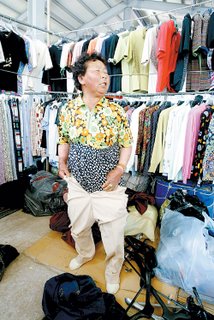countryside 5-day markets, "disappearing"
| "Disappearance" is a common term associated with forms of commerce which are thought to be non-modern, not of this era, but still existing. The "traditional marketplace" (chaerae sijang) in cities is one of them, 5-day markets (5-iljang) in countryside the other. But at least during the quick phase of the urbanization and the growth of Seoul, the number of marketplaces and shops in those markets in Seoul grew faster than the population. Figures used in counting from Seoul 20segi saenghwal, munhwa pyônch'ônsa [History of the change of life and culture in in 20th century Seoul], Seoul Sijông Kaebal Yôn'guwôn 2001. The number of 5-day markets (held every 5 days) was 1200 in the end of 1960s, but around 650 at the present, according to the article linked below. But considering that the 5-day markets are held mostly in rural areas and that the migration to cities since 1960s has been huge, the reduction is not that dramatic as it seems. Anyway, here's a Joongang Ilbo photographic story on a 5-day market. Just once again I pay attention how in stories like this the essence of Koreanness is depicted to be found in places like a 5-day market, the chôngsô, "mentality" of Koreans, the chông (情), humane affection. And the photographs are fine.   Upper left: Gangwon-do, Yeongweol-gun. Upper right: Jeolla nam-do, Gurye. Lower left: Jeolla nam-do Gokseong-gun. Lower right: Jeolla nam-do, Haenam.   (All photographs from Joongang Ilbo.) Categories at del.icio.us/hunjang: photography ∙ marketplaces ∙ modernization |



Comments to note "countryside 5-day markets, "disappearing"" (Comments to posts older than 14 days are moderated)
Write a Comment